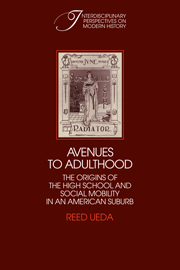Book contents
- Frontmatter
- Contents
- Acknowledgments
- Introduction
- 1 Farm village to commuter suburb
- 2 The evolution of educational leadership
- 3 The free high school
- 4 The rise of Yankee city and the prolongation of schooling
- 5 Popularizing high school: “the college of the people”
- 6 The origins of high school youth culture
- 7 Educational opportunity and social mobility
- 8 The birth of progressive reform and the junior high school
- Conclusion: The high school in the light of history
- Appendix I Courses of study
- Appendix II Sources and methods
- Appendix III Students and households
- Appendix IV Supplementary household data
- Notes
- Index
4 - The rise of Yankee city and the prolongation of schooling
Published online by Cambridge University Press: 04 August 2010
- Frontmatter
- Contents
- Acknowledgments
- Introduction
- 1 Farm village to commuter suburb
- 2 The evolution of educational leadership
- 3 The free high school
- 4 The rise of Yankee city and the prolongation of schooling
- 5 Popularizing high school: “the college of the people”
- 6 The origins of high school youth culture
- 7 Educational opportunity and social mobility
- 8 The birth of progressive reform and the junior high school
- Conclusion: The high school in the light of history
- Appendix I Courses of study
- Appendix II Sources and methods
- Appendix III Students and households
- Appendix IV Supplementary household data
- Notes
- Index
Summary
After the Civil War, a Republican city government widened opportunities for home ownership in Somerville by keeping taxes low, expanding municipal services, and extending rapid transit. By providing attractive living conditions, the suburb helped relieve the pressures generated by competition for housing in the Hub City of Boston. Postwar prosperity made the Republican fathers optimistic about the consequences of their public policies.
Growth, however, had introduced new ethnic and class tensions. Besides receiving mobile white-collar employees who built new homes, Somerville attracted a swelling population of Irish Catholics and low-skilled workers who toiled in the burgeoning factories. Correspondingly, the labor market experienced an expansion of white-collar jobs and semiskilled industrial employment, while skilled posts failed to grow as rapidly.
Citizens worried that a dynamic economy alone could not assure the smooth growth of opportunity and the maintenance of social order. Poverty and inequality threatened to increase under intensifying population pressure, the depersonalizing of human relationships, the proletarianization of workers, and the fear dividing Yankees and immigrants. City fathers believed that the public school's role had to be expanded to preserve economic opportunity and to heal social divisions. The schools had to reach more students from a greater diversity of backgrounds and, most importantly, lengthen their educational careers to provide the extensive preparation to face life in an industrial society. In pursuing these goals, educators systematized the learning experience to inculcate in the future generation of city dwellers common standards of judgment and habits of thought that would promote ordered patterns of coexistence.
- Type
- Chapter
- Information
- Avenues to AdulthoodThe Origins of the High School and Social Mobility in an American Suburb, pp. 59 - 88Publisher: Cambridge University PressPrint publication year: 1987



